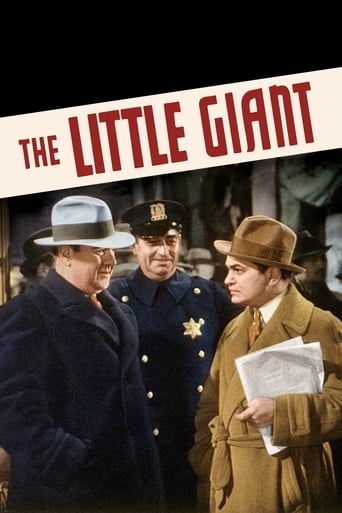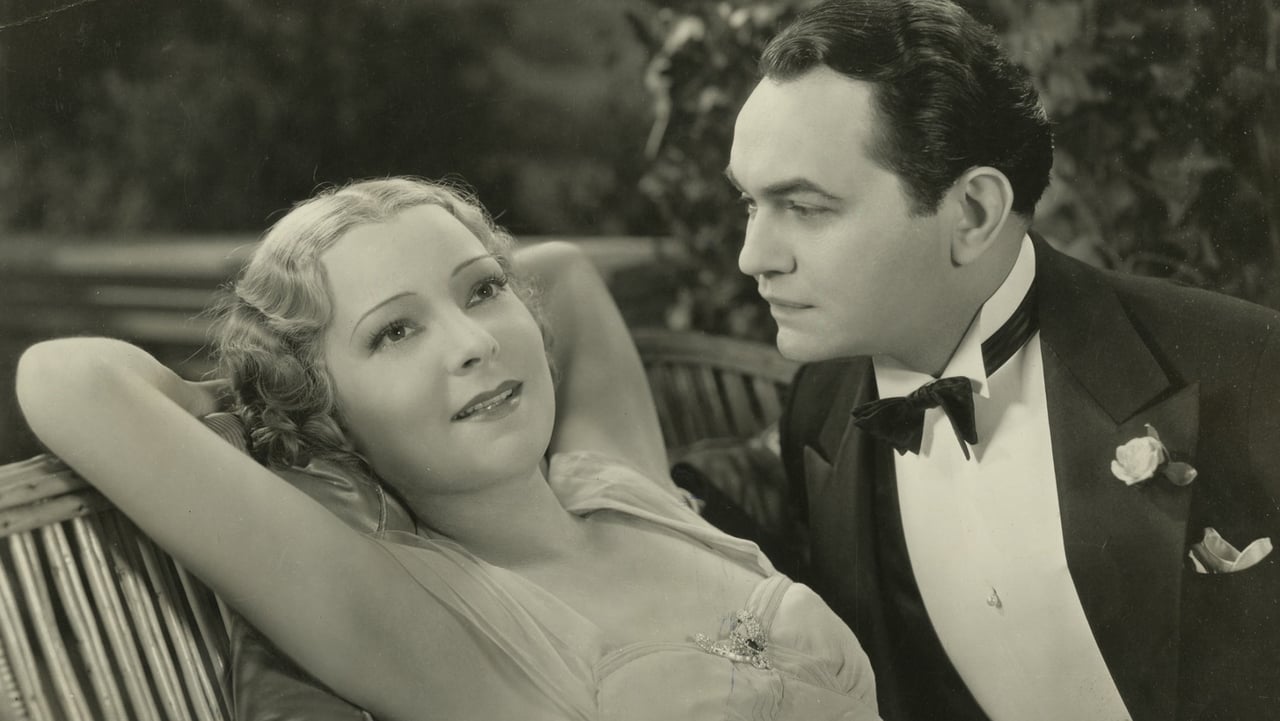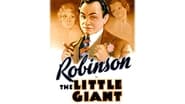GManfred
Prohibition ends and gangster boss Bugsy Ahearn, like so many during the depression, finds himself unemployed. What to do? Fortunately, he has laid aside much of his ill-gotten gains and has no money worries. So he decides to improve himself, to acquire some culture and move in elite circles. And therein lies a very funny story.Edward G. Robinson shows a flair for comedy and shows off some of his immense talent as a social climber who decides to shoot the moon. He moves from Chicago to the West Coast, buys a mansion and falls for a lady from a family of swindlers, and generally falls into a series of mishaps, each one funnier than the last. He gets excellent support from Mary Astor, who becomes his guide to the finer points of becoming 'quality'.You will gain great respect for Robinson if you've only seen him in tough-guy roles, as he carries the picture as a society naif in this written-for-the-screen comedy. There are no dead spots, either, as the story moves along briskly in an enjoyable 75 minutes. It was shown at Cinefest, Columbus, O., 6/13.
ferbs54
Most lovers of classic Hollywood film know what an outstanding and versatile dramatic actor Romanian-born Edward G. Robinson could be. In a career that stretched over four decades, Robinson appeared in an astonishing number of quality films, and even the lesser of his pictures were made interesting and watchable by his mere presence. Fewer viewers, I have a suspicion, may recall how adept Robinson could be at comedy, but for proof of this, one need look no further than one of the actor's pre-Code efforts, "The Little Giant." Released in May 1933, this was not only Eddie's first comedic role, but indeed, the very first gangster comedy ever made. Produced by First National Pictures, which had been taken over by Warner Bros. in 1928, the film's mash-up of genres was successful enough to pave the way for later gangster comedies featuring Robinson. John Ford's "The Whole Town's Talking" (1935, and featuring Jean Arthur in her breakthrough role) was perhaps the best of the bunch, followed in 1938 by the borderline screwball "A Slight Case of Murder" and 1942's very funny "Larceny, Inc.," and even some "serious" gangster pictures featuring Robinson, such as 1938's "The Amazing Dr. Clitterhouse" and 1940's "Brother Orchid," would contain a goodly leavening of humor. In short, the gangster comedy, as initially proved by "The Little Giant," was a very viable entertainment.In the film, Eddie plays a Chicago mobster named Francis "Bugs" Ahearn. When Prohibition ends in 1933 (the film was most certainly timely!) and booze is suddenly made legal, Bugs decides to call it quits, pay off his boys, go legit, get some culture and move to Santa Barbara, CA. He's got "a million and a quarter salted away," and with that filthy lucre and his childhood buddy Al (Russell Hopton, very funny here in his straight-man role), he arrives at a posh hotel by the sea, ready to crash high society. After falling in love with a glamorous "skirt" named Polly Cass (Helen Vinson), Bugs decides to buy a ritzy 20-room, 14-bath mansion to impress her, and makes his pretty Realtor, Ruth (a very appealing Mary Astor), both his house manager and social secretary. But what Bugs doesn't know is that Polly is a con artist, from an entire family of con artists; indeed, a family that makes Janet Gaynor's family of crooks in 1938's "Young in Heart" seem perfectly angelic! It seems as if Bugs might be learning polo and buying a wedding ring in vain....Featuring wonderfully snappy dialogue, well-drawn characters and big laffs, "The Little Giant" is an absolute delight from start to finish. The film is remarkably compact, and manages to pack quite a bit of yucks and story into its brief 74-minute running time. Indeed, director Roy del Ruth never lets the pace flag; he would not work with Robinson again, but would reunite with Astor the following year for a picture called "Upperworld," one that I have not seen but which has a good reputation. Robinson and Astor have some definite chemistry on screen, and the viewer wonders what Bugs sees in the comparatively homely Polly when Astor's Ruth is so much brighter, sweeter, prettier...and certainly more honest. Astor's face in the early '30s seemed a bit softer and rounder than the more angular look she boasted in the '40s, and her Ruth Wayburn here is ever so much more attractive than the Brigid O'Shaughnessy that Humphrey Bogart would encounter in 1941's "The Maltese Falcon." Robinson and Astor had apparently appeared together once before, in the little-seen 1923 silent "The Bright Shawl" (also starring Richard Barthelmess, Dorothy Gish and William Powell--what a cast!--and with Astor playing Robinson's daughter), and would also appear together in 1934's "The Man With Two Faces." Being one of the last of the pre-Code films, "The Little Giant" sports some lines that modern-day audiences might not be prepared for, such as the reference to giving someone "the finger," and when Bugs refers to the upper-crust snobs as a bunch of "fags"! And then there is the startling early scene in which Bugs shows Al a piece of abstract art (Robinson, it should be remembered, would, years later, own one of the largest private art collections in the world, and one that he had to sell in 1956 to pay off a divorce settlement) and asks his buddy, "You ever seen anything like that before?" Al's response: "Not since I've been off cocaine"! You've gotta love these pre-Code gems! Anyway, Robinson seems to be having a ball here, turning his 1931 "Little Caesar" role of Rico Bandello on its head and squeezing it for laffs; he even gets to look straight into the camera once, hilariously. And yet, this tough guy with a decent heart manages to arouse the viewer's sympathy, too, as he haplessly mingles with the snooty society folk and chases a girl who is waaaaay wrong for him. How satisfying it is, then, when Bugs uses some Chicago strongarm tactics toward the film's finale to rectify the wrongs done him by the Cass family! And what a sweet little ending, too, to wrap things up with! An enormously pleasing entertainment, it's no wonder that "The Little Giant" opened up a whole new genre of film!
MartinHafer
This film begins with the election of Franklin Roosevelt and an end to Prohibition. As Edward G. Robinson is the head of a gang selling illegal liquor, he knows his days of riches and glory are over. Instead of continuing in a life of crime, he wants to return in style and live among the gentry. The only problem is that although he thinks he's got class, he's a total clod...a likable clod, but a clod nonetheless. And, in society, he sticks out like a sore thumb. He is only accepted, eventually, by some selfish swells who only want him around for a chance to drain him of his money. The problem is that Robinson is such a sucker, he has no idea he's being played. At the same time, his personal secretary (Mary Astor) has fallen for him and she knows what sort of people his new "friends" really are but is afraid to tell him.Despite Robinson being an ex-crook AND chump, he's excellent here because no matter what he was like, you can't help but feel sorry for him. There is a certain vulnerability and charm about him--making this film work very well. He also seemed to have a nice knack for comedy--something that would become very apparent with later successes such as THE WHOLE TOWN'S TALKING and LARCENY INCORPORATED. His friend and sidekick, Russell Hopton, is also quite good--and it's surprising that he didn't get more work with such excellent performances.Overall, this is one of the best gangster flicks of the 1930s. Exceptionally well written and acted, and especially great in the end. Fully of laughs and wonderful moments--especially when his friends from Chicago come to save the day. A film not to be missed.
theowinthrop
It is generally conceded that Edward G. Robinson (his memoirs tell us that the "G" was for "Gould", but it was a made-up name, so he just left it a "G") was one of the finest actors in Hollywood history, who repeatedly missed out on deserved "Oscar" recognition, although he did get a career "Oscar" shortly before his death in 1971. But most of the performances he is best recalled for ("Little Caesar", "Double Indemnity", "The Ten Commandments", "Dr. Ehrlich's Magic Bullet", "The Sea Wolf", "Key Largo", "The Woman In The Window", "All My Sons") were dramatic parts. In fact, many were outright villains. He did play comedy, and when the film was intelligent it was usually with good results. In particular his gangster comedies, "A Slight Case of Murder", "Larceny, Inc.", and "The Whole Town is Talking", show him to best effect. And there is this early comedy (I believe it was Robinson's first comic turn).Bugs Ahearn is like Remy Marko in "A Slight Case of Murder". Both are beer baron racketeers from the 1920s and early 1930s, who have made a pile, but face the end of "prohibition" by trying to turn legit - or as close to legit as possible. Remy (sticking to the New York Metropolitan area) decided to continue his brewery as a competitor with now other legitimate beer companies, not realizing (until it's almost too late) how dreadful his swill tastes. Bugs decides he's made enough, pulls up stakes and heads for the West Coast. He will now try to join the "beautiful people" in high society. But while Remy has his loyal gang members and his wife and daughter to support him, Bugs goes it alone. And is taken to the cleaners.I don't think that the view of the rich that appear in these films (and other gangster films of the 1930s) would be as dark again until the last ten years. Although some of the film noir movies showed a seedy side to the wealthy and prominent (notably in those films based on Raymond Chandler and Dashiel Hammett novels), the films of the last decade made in the wake of scandals like EXXON, certainly made the bulk of the public question the rich. In 1933 the same serious questioning was going on. Economic heroes of the 1920s like Michael Meehan, Jesse Livermore, William C. Durant, Samuel Insull, and Richard Whitney became criminals or pariahs in the 1930s as investigations revealed their thefts or skirting of the laws. Even J.P. Morgan 2nd (an uncle of Whitney by marriage) was shown to have made a "mistake" in underestimating his income tax in the early 1930s. Comparatively speaking, gangsters like Remy or Bugs were more openly criminal than their white collar counterparts - who stole millions from small investors, and did not break laws to service a need for mild alcoholic beverages. So it was easy to side with Bugs or Remy when they face these secret villains - like the rest of the population did.Except for former wealthy woman Mary Astor, who finds she likes Bugs, all of the wealthy people in this film are parasites who see Bugs as dirt to use to get rid of worthless stock before they are left holding the bag. The choice of Burton Churchill as the head of the Cass family, as unctuous a villain in the 1930s as you could find, was perfect. His respectable demeanor hiding a wolf-like passion for money at the expense of the gullible - here Bugs, who is smitten by Churchill's equally villainous daughter Helen Vinson.At the end of "A Slight Case Of Murder" Remy found out the error of his beastly beer brew, and snookered the white collared villains (bankers) into giving his loan an extension while he found a new beer formula that worked. Here the ending is more satisfactory, with Bugs asking his pals from Chicago to assist him, and forcing Churchill and his confederates to buy back the worthless stock. The scenes of this were very satisfying to depression America audiences.


 AD
AD




